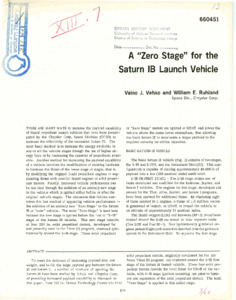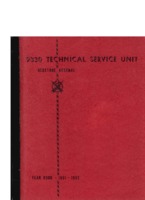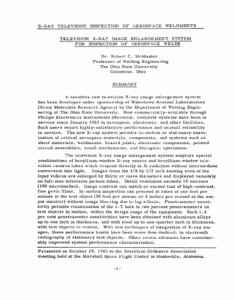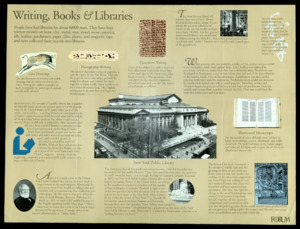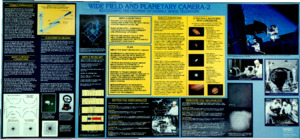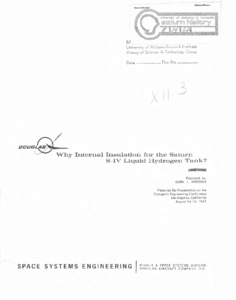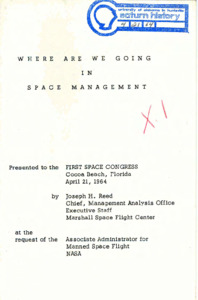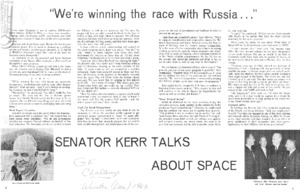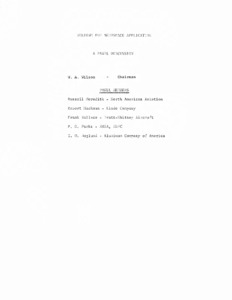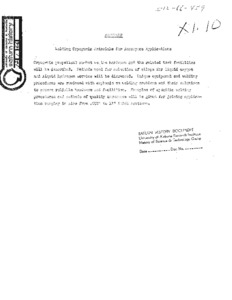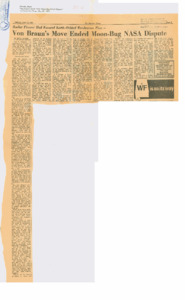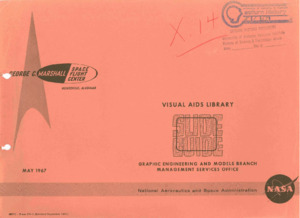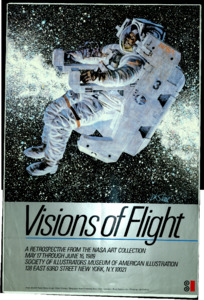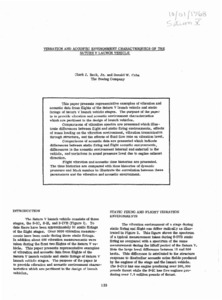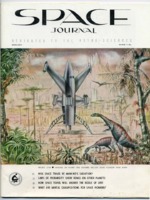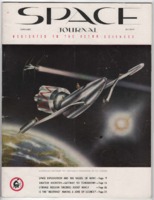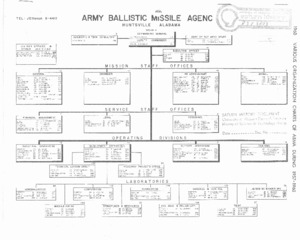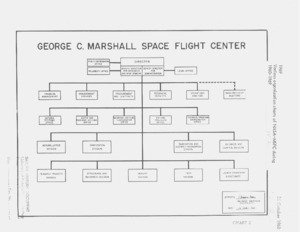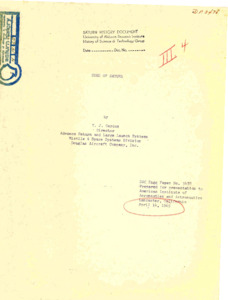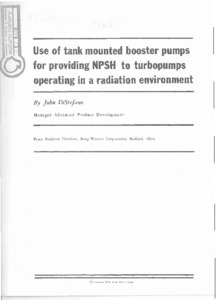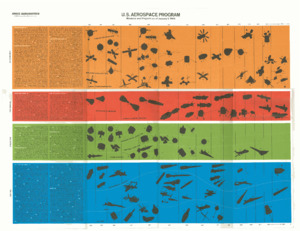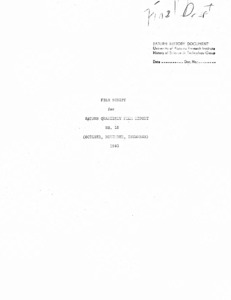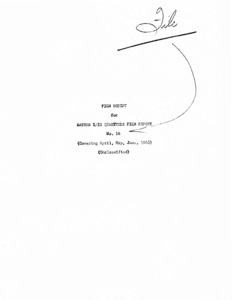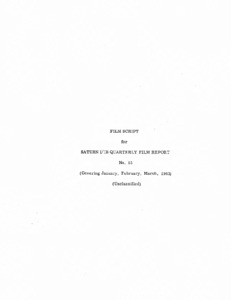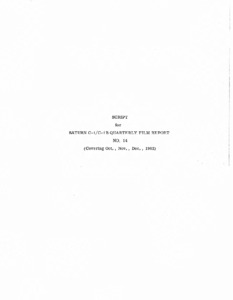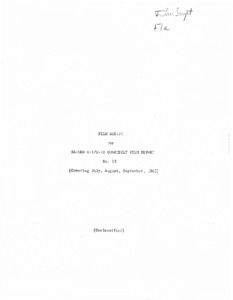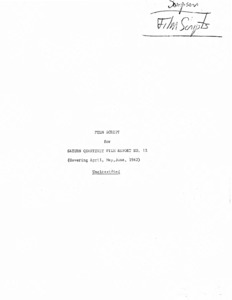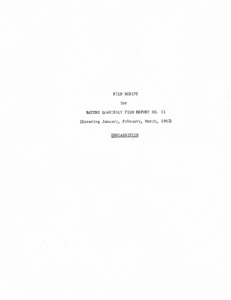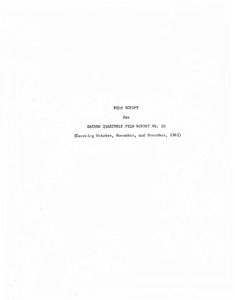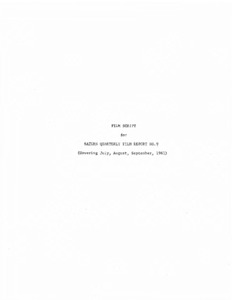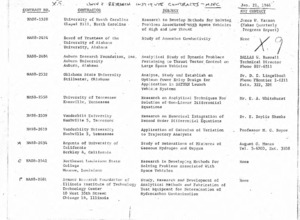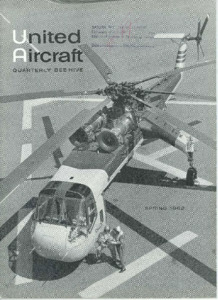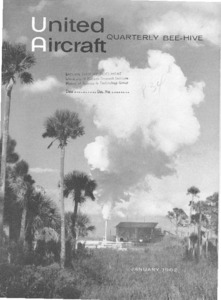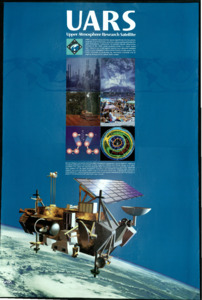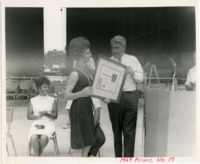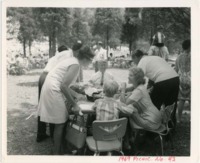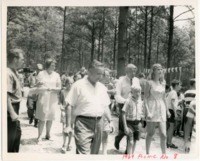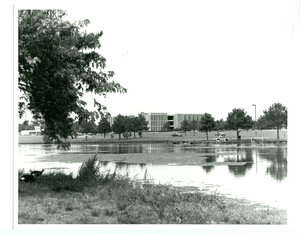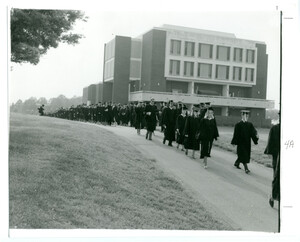
Browse Items (7888 total)
Sort by:
-
"A 'Zero Stage' for the Saturn IB Launch Vehicle."
To meet the demands of increasing payload size and weight, and to fill the large payload gap between the Saturn IB and Saturn V, a number of methods of uprating the Saturn IB have been studied by NASA and Chrysler Corp. of providing increased payload capability is discussed in this paper. Four 120 in. United Technology Center UA-1205 solid propellant motors, originally developed for the Air Force Titan III program, are clustered around the S-IB first stage of the Saturn IB launch vehicle. These four solid propellant motors provide the total thrust for liftoff of the vehicle, with S-IB stage ignition occurring just prior to burn-out and separation of the solid propellant motors. The term "Zero Stage" is applied to this added stage. -
"X-ray television inspection of aerospace weldments : Television x-ray image enlargement system for inspection."
A sensitive new television X-ray image enlargement system has been developed under sponsorship of Watertown Arsenal Laboratories (Army Materials Research Agency) by the Department of Welding Engineering of The Ohio State University. Now commercially-available through Philips Electronics Instruments (Norelco), complete systems have been in service since January 1963 in aerospace, electronic, and other facilities. Such users report highly- satisfactory performance and unusual reliability in service. The new X-ray system permits in-motion or stationary examination of critical aerospace materials, components, and systems such as sheet materials, weldments, brazed joints, electronic components, printed circuit assemblies, small mechanisms, and biological specimens. -
Writing, Books, & Libraries....
Informational poster with a beige background. The poster has blocks of text accompanied by illustrations and photographs. -
WIDE FIELD AND PLANETARY CAMERA-2 RECOVERING THE PROMISE OF HUBBLE SPACE TELESCOPE....
Informational poster containing text and images about the telescope. The main background is light blue, while text box backgrounds are either dark blue or yellow. -
"Why internal insulation for the Saturn S-IV liquid hydrogen tank?."
Prepared for presentation at the Cryogenic Engineering Conference, Los Angeles, California, August 14-16, 1962.; There is no page 8. -
"Where are we going in space management."
Presented to the First Space Congress, Cocoa Beach, Florida, April 21, 1964 by Joseph H. Reed, Chief, Management Analysis Office, Executive Staff, Marshall Space Flight Center at the request of the Associate Administrator for Manned Space Flight, NASA -
"We're winning the race with Russia."
Partial article discussing the United States' victories in the space-race over Russia. -
"Welding for aerospace application : a panel discussion."
Original is a photocopy; W. A. Wilson, Chairman; Russell Meredith, North American Aviation; Robert Hackman, Linde Company; Frank Wallace, Pratt-Whitney Aircraft; P.G. Parks, NASA, MSFC; G. O. Hoglund, Aluminum Company of America. -
"Welding cryogenic materials for aerospace applications."
Cryogenic propellant rocket engine hardware and the related test facilities will be described. Methods used for selection of alloys for liquid oxygen and liquid hydrogen service will be discussed. Unique equipment and welding procedures are reviewed with emphasis on welding problems and their solutions to assure reliable hardware and facilities. Examples of specific welding procedures and methods of quality assurance will be given for joining application ranging in size from .001" to 11" thick sections. -
Transplanted Rocket Pioneers.
The information in this dataset is reproduced from Charles Lundquist's 2014 monograph Transplanted Rocket Pioneers. The information includes biographical and professional information that he compiled to produce the book. Each individual represented in the dataset also has a vertical file in the Lundquist Collection at UAH.
Transplanted Rocket Pioneers is a recognition of the early members of the von Braun rocket team, many of whom were key players in the successful moon landing. Many historians conclude that the lunar missions of the Apollo Program could not have been possible without the leadership and experience provided by a corps of engineers, scientists and managers transplanted from Europe to the Unites States after World War II. This fact motivated Dr. Lundquist to deposit this work in the Archives of the Library at the University of Alabama in Huntsville by assembling a file on each of the individuals who came from Europe to participate in the rocketry activities in Huntsville, or, in a few cases, individuals who had other ties to Huntsville.
This dataset includes a standard one-page summary sheet for each subject. Although most sheets are relatively complete, some data are still missing.
The first two lines on each page records fundamental identification information:
Family name Date of birth Place of birth Given names Date of death Place of death
The next standard entry is a statement of the extent of the Archives Holdings, either i) A primary collection of documents housed in one or more banker boxes, usually a separate individual collection ii) A secondary collection in a standard archive box, or iii) a file folder. Next, if there is an oral or video history for the individual, this fact is noted. A statement about the highest education levels of the individual follows. The next five entries, in chronological order, record whether the individual participated in activities at five sites:
1. Raketenflugplatz-Kummersdorf: Individuals engaged in the activities at these sites of early rocket development experiments sponsored first by VfR and subsequently by the German Army.
2. Peenemünde: Included here are individuals who participated in Peenemünde programs under several auspices, including as Army civilian employees, as members of the German military, as contractor employees on site or visiting as needed, and as university employees collaborating as required.
3. Fort Bliss: Individuals who were brought to Fort Bliss from 1945 to 1950.
4. GMDD-ABMA: Individuals who came to Huntsville, Alabama to work for the US Army rocket programs in the decade 1950 to 1960.
5th MSFC: Individuals who were employed by the NASA Marshall Space Flight Center in the 1960s.
Some people had various relationships with UAH and that is so noted. Additionally, a statement of immigration details is noted if pertinent. Finally, a great variety of incidental information is included under Incidental Remarks.
UAH Special Collections welcomes additions of biographical materials to the vertical file in the Charles Lundquist Collection. Please note that the work is that of Dr. Lundquist and may contain errors or omissions which are solely the product of his work on the project, as noted in the introduction of the work.: " Finally, it is pertinent to note that any document containing large files will surely have some mistakes or omission. Any errors are the responsibility of the author alone." As was the wish of Dr. Lundquist, we will strive to make factual corrections to the online copy when necessary.
-
Visual aids library slide guide.
This document includes revisions. There are missing pages from page 237-238. This reference document catalogues all MSFC oriented visual aids filed in the Visual Aids Library of Marshall Space Flight Center. These visual aids are updated by the Graphic Engineering & Models Branch, Industrial Operations Program Management Information Office, and the Research and Development Operations Management Office. The purpose of the Visual Aids Library is to provide management data visuals in the form of slides (3 X 4 and 2 X 2), or black and white prints, to MSFC offices and laboratories, and other centers, who have a valid requirement. The visual aids are issued on a loan basis in order to obtain as wide a use for each visual and to assure that the latest revisions are incorporated in the issued item. Visuals may be ordered from the Visual Aids Library, located on the 10th floor of building 4200 (Phone 876-7237, 876-6960, 876-0983). In addition to the visuals published in this book, photographs from prime contractors are available from Industrial Operations, Program Management Information Office, Room 621, building 4201. Visuals with erroneous or obsolete information should be brought to the attention of the Visual Aids Library, preferably in writing, so that corrections can be made immediately. This publication will be kept current through distribution of pages of new visuals and notification will be made on obsolete visuals so they may be crossed out in the catalogue. Comments and suggestions concerning this publication will be greatly appreciated. Changes in the distribution lists should be directed to Mr. Gordon 0. Willhite, or Mrs. Opal Tabor, Visual Aids Library, MS-G. -
Visions of Flight....
Artwork of astronaut floating in space. Text at the bottom details an art exhibit featuring paintings about NASA history. -
"Vibration and acoustic environment characteristics of the Saturn V launch vehicle."
This paper presents representative examples of vibration and acoustic data from flights of the Saturn V launch vehicle and static firings of Saturn V launch vehicle stages. The purpose of the paper is to provide vibration and acoustic environment characteristics which are pertinent to the design of launch vehicles -
Space Journal, vol. 1, no. 5, March-May 1959.
This issue includes a statement announcing Space Journal's termination of all connections with the U.S. military and with the Rocket City Astronomical Association. At the time, commander of the Army Ballistic Missile Agency (ABMA) at Redstone Arsenal Gen. John B. Medaris was concerned that the publishers and writers, all in the employ of ABMA, were using their government positions for personal gain through the magazine. Topics covered in the issue include the dangers and feasibility of space travel, designing buildings for life on the Moon, and the existence of life elsewhere in the universe. -
Organization charts of ABMA during 1957-1960.
Includes letter to Mr. David Christensen, University of Alabama Research Institute. -
Various organization charts of NASA-MSFC during 1960-1969.
A collection of organization charts from years 1960 to 1969. -
"Uses of Saturn."
Saturn and Apollo hardware will not have realized their ultimate potential for space exploration after the project lunar landing is complete. To accomplish the Apollo lunar landing program, an immense backlog of technology, facilities, and booster capability will have been built up, and we believe proper utilization of this resource will fill the needs for planetary, lunar and earth orbital space exploration for years to come. -
"Use of tank mounted booster pumps for providing NPSH to turbopumps operating in a radiation environment."
This paper outlines the results of a test program which was planned to demonstrate the feasibility of using a tank mounted, all-inducer, high speed liquid hydrogen booster pump to provide NPSH for the turbo pump in a reactor-powered vehicle. The cavitation problem associated with pumpoing liquid hydrogen, when used as a propellant, is further aggravated by localized heating caused by radiation from the reactor. -
"U.S. Aerospace Program: missions and projects as of January 1, 1966."
The document contains four charts labeled "Investigation", "Exploration", "Utilization", and "Control". Each chart is organized chronologically, contains drawings of U.S. Aerospace Program Projects, and incudes written descriptions of each project. -
"Film script for Saturn quarterly film report no. 18."
Unclassified film script of the Saturn I/IB Quarterly Film Report covering October, November, December, 1963. A handwritten note at the top of the title page lables this copy as the "Final Draft". -
"Film script for Saturn I/IB quarterly film report no. 16."
Unclassified film script of the Saturn I/IB Quarterly Film Report covering April, May, June, 1963. There are handwritten notes and edits throughout the document. -
"Film script for Saturn I/IB quarterly film report no. 15."
Unclassified film script of the Saturn I/IB Quarterly Film Report covering January, February, March, 1963. There are handwritten notes and edits throughout the document. -
Script for Saturn C-1/C-1B quarterly film report no. 14 (covering Oct., Nov., Dec., 1962).
Film script reporting on how the Saturn 1 will be used and what its take-off process will look like -
Film script for Saturn C-1/C-1B quarterly film report no. 13 (covering July, August, September, 1962).
Film script reporting on how the Saturn 1 will be used and what its take-off process will look like -
Film script for Saturn quarterly film report no. 12 (covering April, May, June, 1962).
Film script reporting on the testing of the Saturn 1 -
Film script for Saturn quarterly film report no. 11 (covering January, February, March, 1962).
Film script reporting on the construction of the Saturn 1 -
Film script for Saturn quarterly film report no. 10 (covering October, November, December, 1961).
Film script reporting on the construction of the Saturn 1 -
Film script for Saturn quarterly film report no. 9 covering July, August, September, 1961.
Film script reporting on the construction of the Saturn 1 -
"University and research institute contracts awarded by MSFC."
This is a list of contract numbers, contractor, subject and RNT contact. -
"United Aircraft Quarterly Bee-hive:" Spring, 1962: Volume XXXVII, Number 2.
A book containing various articles surrounding the activities and achievements of the Saturn program up to Spring, 1962. -
"United Aircraft Quarterly Bee-hive:" January 1962, Volume XXXVII, Number 1.
A book containing various articles surrounding the activities and achievements of the Saturn program up to January, 1962. -
UARS Upper Atmosphere Research Satellite....
Artwork of the satellite below 6 square photos depicting nature and scientific graphs. -
Wernher von Braun presents an Award of Achievement to Jean Drake at the 1969 MSFC employee picnic.
Drake worked in the Safety Office. Lois Smith is shown seated at left. -
Wernher von Braun with daughter Margrit and son Peter in the crowd at the 1969 MSFC employee picnic.
MSFC Director of Administration and Technical Services David H. Newby is shown in the foreground.
